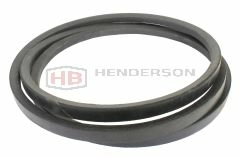- Home
- Power Transmission
- Belts
- V Belts
V Belts - 236" Inch = 5994mm Approx
Classical v belts belts are available from stock at Henderson Bearings, edit your search with our navigation software on the left side of the page. If you can't fine what you are looking for and need assistance please do not hesitate to contact one of our sales professionals Tel:-01425-477787, or email sales@hendersonbearings.co.uk
What are V-belts used for?
V-belts, also known as fan belts, are a type of drive belt used mainly for transferring power between different components in machinery. They are widely used in various sectors such as industrial, automotive, and agricultural. Key uses of V-belts include:
- Transmitting power from the engine to other components like the alternator, air conditioning compressor, power steering pump, and water pump in vehicles.
- Driving conveyors, pumps, and fans in industrial settings.
- Operating machines in agricultural settings, like harvesters and tillers.
How do you size V-belts?
Properly sizing V-belts is essential for the belt's efficiency and durability. Here are the steps you should follow:
- Measure the top width and depth of the belt to determine the required belt profile for the pulleys.
- Figure out the necessary length by measuring the distance between the centers of the two pulleys plus the part around which the belt wraps.
- Always check the manufacturer’s specifications for power requirements and speed to match the belt perfectly to your machinery’s needs.
What are three types of standard V-belts?
There are various V-belts, each crafted for specific applications based on load capacity and efficiency. Three standard V-belts include:
- Classical V-belts: Very common and usable in a wide range of applications, these belts have designations such as A, B, C, each stands for different widths and profiles.
- Narrow V-belts: These belts are less wide yet capable of handling higher loads. They are suitable for compact, high-speed applications.
- Wedge V-belts: Designed similar to narrow V-belts but with even more efficient power transmission capacities and suitable for high-tension situations.
Which is better, V-belts or cog belts?
The choice between V-belts and cogged belts (or synchronous belts) depends on the application’s specific requirements:
- V-belts are better for applications that require flexibility, quieter operation, ease of maintenance, and installation without the need for precise timing.
- Cog belts are ideal for applications requiring precise shaft synchronization. They are more efficient, do not slip, and can handle higher power loads compared to V-belts.
- Belt Inside Length 236" Inch = 5994mm Approx Remove This Item
- 20" Inch = 508mm Approx 1 item
- 21" Inch = 533mm Approx 1 item
- 21.5" Inch = 546mm Approx 1 item
- 22" Inch = 558mm Approx 1 item
- 23" Inch = 584mm Approx 3 items
- 23.75" Inch = 603mm Approx 1 item
- 24" Inch = 609mm Approx 2 items
- 24.75" Inch = 628.65mm Approx 1 item
- 25" Inch = 635mm Approx 3 items
- 25.5" Inch = 647mm Approx 1 item
- 26" Inch = 660mm Approx 3 items
- 26.5" Inch = 673mm Approx 3 items
- 27" Inch = 685mm Approx 3 items
- 27.5" Inch = 698mm Approx 1 item
- 28" Inch = 711mm Approx 3 items
- 28.5" Inch = 723mm Approx 1 item
- 29" Inch = 736mm Approx 3 items
- 29.5" Inch = 749mm Approx 3 items
- 30" Inch = 762mm Approx 3 items
- 30.5" Inch = 774mm Approx 3 items
- 31" Inch = 787mm Approx 3 items
- 31.5" Inch = 800mm Approx 2 items
- 32" Inch = 812mm Approx 3 items
- 32.5" Inch = 825mm Approx 3 items
- 33" Inch = 838mm Approx 3 items
- 33.5" Inch = 850mm Approx 2 items
- 34" Inch = 863mm Approx 3 items
- 34.5" Inch = 876mm Approx 3 items
- 35" Inch = 889mm Approx 3 items
- 35.5" Inch = 901mm Approx 4 items
- 36" Inch = 914mm Approx 3 items
- 36.5" Inch = 927mm Approx 3 items
- 37" Inch = 939mm Approx 3 items
- 37.5" Inch = 952mm Approx 3 items
- 38" Inch = 965mm Approx 3 items
- 38.50" Inch = 977mm Approx 2 items
- 39" Inch = 990mm Approx 3 items
- 39.5" Inch = 1003mm Approx 3 items
- 40" Inch = 1016mm Approx 3 items
- 40.5" Inch = 1028mm Approx 3 items
- 41" Inch = 1041mm Approx 3 items
- 41.5" Inch = 1054mm Approx 1 item
- 42" Inch = 1066mm Approx 3 items
- 42.5" Inch = 1079mm Approx 3 items
- 43" Inch = 1092mm Approx 3 items
- 43.25" Inch = 1098mm Approx 1 item
- 44" Inch = 1117mm Approx 3 items
- 44.5" Inch = 1130mm Approx 1 item
- 45" Inch = 1143mm Approx 3 items
- 45.25" Inch = 1149mm Approx 1 item
- 45.5" Inch = 1155mm Approx 2 items
- 46" Inch = 1168mm Approx 3 items
- 46.5" Inch = 1181mm Approx 3 items
- 47" Inch = 1193mm Approx 3 items
- 47.25" Inch = 1200mm Approx 1 item
- 47.5" Inch = 1206mm Approx 1 item
- 48" Inch = 1219mm Approx 3 items
- 48.5" Inch = 1231mm Approx 1 item
- 49" Inch = 1244mm Approx 3 items
- 49.5" Inch = 1257mm Approx 2 items
- 50" Inch = 1270mm Approx 3 items
- 50.5" Inch = 1282mm Approx 2 items
- 50.75" Inch = 1289mm Approx 1 item
- 51" Inch = 1295mm Approx 3 items
- 52" Inch = 1320mm Approx 3 items
- 53" Inch = 1346mm Approx 3 items
- 53.25" Inch = 1352mm Approx 1 item
- 54" Inch = 1371mm Approx 3 items
- 55" Inch = 1397mm Approx 3 items
- 56" Inch = 1422mm Approx 3 items
- 57" Inch = 1447mm Approx 3 items
- 58" Inch = 1473mm Approx 3 items
- 59" Inch = 1498mm Approx 3 items
- 59.5" Inch = 1511mm Approx 1 item
- 60" Inch = 1524mm Approx 3 items
- 61" Inch = 1549mm Approx 3 items
- 62" Inch = 1574mm Approx 2 items
- 63" Inch = 1600mm Approx 2 items
- 64" Inch = 1625mm Approx 3 items
- 65" Inch = 1651mm Approx 3 items
- 66" Inch = 1676mm Approx 3 items
- 67" Inch = 1701mm Approx 3 items
- 68" Inch = 1727mm Approx 3 items
- 68.5" Inch = 1739mm Approx 1 item
- 69" Inch = 1752mm Approx 3 items
- 70" Inch = 1778mm Approx 3 items
- 70.75" Inch = 1797mm Approx 1 item
- 71" Inch = 1803mm Approx 3 items
- 72" Inch = 1828mm Approx 3 items
- 73" Inch = 1854mm Approx 3 items
- 73.5" Inch = 1866mm Approx 2 items
- 74" Inch = 1879mm Approx 2 items
- 74.75" Inch = 1898mm Approx 1 item
- 75" Inch = 1905mm Approx 2 items
- 76" Inch = 1930mm Approx 2 items
- 77" Inch = 1955mm Approx 2 items
- 77.5" Inch = 1968mm Approx 1 item
- 78" Inch = 1981mm Approx 3 items
- 79" Inch = 2006mm Approx 3 items
- 80" Inch = 2032mm Approx 2 items
- 81" Inch = 2057mm Approx 2 items
- 82" Inch = 2082mm Approx 3 items
- 83" Inch = 2108mm Approx 2 items
- 84" Inch = 2133mm Approx 2 items
- 85" Inch = 2159mm Approx 2 items
- 86" Inch = 2184mm Approx 2 items
- 86.5" Inch = 2197mm Approx 2 items
- 87" Inch = 2209mm Approx 2 items
- 88" Inch = 2235mm Approx 2 items
- 88.5" Inch = 2247mm Approx 2 items
- 89" Inch = 2260mm Approx 2 items
- 90" Inch = 2286mm Approx 2 items
- 91" Inch = 2331mm Approx 1 item
- 91.5" Inch = 2324mm Approx 2 items
- 92" Inch = 2336mm Approx 1 item
- 92.5" Inch = 2349mm Approx 1 item
- 93" Inch = 2362mm Approx 1 item
- 94" Inch = 2387mm Approx 2 items
- 95" Inch = 2413mm Approx 2 items
- 96" Inch = 2438mm Approx 2 items
- 96.5" Inch = 2451mm Approx 1 item
- 97" Inch = 2463mm Approx 1 item
- 98" Inch = 2489mm Approx 2 items
- 99" Inch = 2514mm Approx 2 items
- 100" Inch = 2540mm Approx 2 items
- 101" Inch = 2565mm Approx 2 items
- 102" Inch = 2590mm Approx 2 items
- 103" Inch = 2616mm Approx 2 items
- 104" Inch = 2641mm Approx 2 items
- 105" Inch = 2667mm Approx 1 item
- 106" Inch = 2692mm Approx 2 items
- 107" Inch = 2717mm Approx 2 items
- 108" Inch = 2743mm Approx 1 item
- 109" Inch = 2768mm Approx 1 item
- 110" Inch = 2794mm Approx 2 items
- 112" Inch = 2844mm Approx 2 items
- 112.5" Inch = 2857mm Approx 1 item
- 113" Inch = 2870mm Approx 1 item
- 114" Inch = 2895mm Approx 2 items
- 115" Inch = 2921mm Approx 2 items
- 116" Inch = 2946mm Approx 2 items
- 117" Inch = 2971mm Approx 1 item
- 118" Inch = 2997mm Approx 2 items
- 119" Inch = 3022mm Approx 1 item
- 120" Inch = 3048mm Approx 2 items
- 121" Inch = 3073mm Approx 1 item
- 122" Inch = 3098mm Approx 2 items
- 123" Inch = 3124mm Approx 1 item
- 124" Inch = 3149mm Approx 2 items
- 125" Inch = 3175mm Approx 2 items
- 126" Inch = 3200mm Approx 1 item
- 127" Inch = 3225mm Approx 2 items
- 128" Inch = 3251mm Approx 2 items
- 129" Inch = 3276mm Approx 1 item
- 130" Inch = 3302mm Approx 2 items
- 131" Inch = 3327mm Approx 1 item
- 132" Inch = 3352mm Approx 2 items
- 133" Inch = 3378mm Approx 1 item
- 134" Inch = 3403mm Approx 2 items
- 135" Inch = 3429mm Approx 1 item
- 136" Inch = 3454mm Approx 2 items
- 138" Inch = 3505mm Approx 1 item
- 139" Inch = 3530mm Approx 1 item
- 140" Inch = 3556mm Approx 2 items
- 142" Inch = 3606mm Approx 2 items
- 144" Inch = 3657mm Approx 2 items
- 145" Inch = 3683mm Approx 1 item
- 146" Inch = 3708mm Approx 1 item
- 147" Inch = 3733mm Approx 1 item
- 148" Inch = 3759mm Approx 2 items
- 150" Inch = 3810mm Approx 1 item
- 151" Inch = 3835mm Approx 1 item
- 152" Inch = 3860mm Approx 1 item
- 154" Inch = 3911mm Approx 2 items
- 155" Inch = 3937mm Approx 2 items
- 156" Inch = 3962mm Approx 2 items
- 157" Inch = 3987mm Approx 1 item
- 158" Inch = 4013mm Approx 2 items
- 160" Inch = 4064mm Approx 1 item
- 161" Inch = 4089mm Approx 1 item
- 162" Inch = 4114mm Approx 2 items
- 163" Inch = 4140mm Approx 1 item
- 165" Inch = 4191mm Approx 1 item
- 167" Inch = 4241mm Approx 1 item
- 168" Inch = 4267mm Approx 1 item
- 170" Inch = 4318mm Approx 1 item
- 173" Inch = 4394mm Approx 2 items
- 175" Inch = 4445mm Approx 1 item
- 177" Inch = 4495mm Approx 2 items
- 180" Inch = 4572mm Approx 2 items
- 182" Inch = 4622mm Approx 1 item
- 185" Inch = 4699mm Approx 1 item
- 186" Inch = 4724mm Approx 1 item
- 188" Inch = 4775mm Approx 1 item
- 187" Inch = 4749mm Approx 2 items
- 192" Inch = 4876mm Approx 1 item
- 194" Inch = 4927mm Approx 1 item
- 195" Inch = 4953mm Approx 1 item
- 196" Inch = 4978mm Approx 1 item
- 197" Inch = 5003mm Approx 2 items
- 200" Inch = 5080mm Approx 1 item
- 204" Inch = 5181mm Approx 1 item
- 207" Inch = 5257mm Approx 1 item
- 208" Inch = 5283mm Approx 1 item
- 210" Inch = 5334mm Approx 2 items
- 215" Inch = 5461mm Approx 1 item
- 217" Inch = 5511mm Approx 1 item
- 219" Inch = 5562mm Approx 1 item
- 220" Inch = 5588mm Approx 1 item
- 223" Inch = 5664mm Approx 1 item
- 225" Inch = 5715mm Approx 1 item
- 229" Inch = 5816mm Approx 1 item
- 236" Inch = 5994mm Approx 1 item
- 237" Inch = 6019mm Approx 1 item
- 240" Inch = 6096mm Approx 1 item
- 247" Inch = 6273mm Approx 1 item
- 255" Inch = 6477mm Approx 1 item
- 259" Inch = 6578mm Approx 1 item
- 276" Inch = 7010mm Approx 1 item
- 285" Inch = 7239mm Approx 1 item
- 300" Inch = 7620mm Approx 1 item
- 315" Inch = 8001mm Approx 1 item


